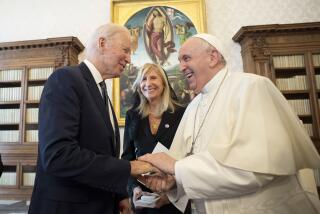The Primitive and Pragmatic in Pentecostalism, but Not the Dark Side
Few religious groups in the United States have attracted as much antagonism as Pentecostal Christians. Known derogatorily as âHoly Rollers,â Pentecostals have a reputation for delivering fire-and-brimstone sermons, speaking in tongues and writhing in ecstasy. They are adroit missionaries, and they have managed not only to survive the onslaught of secularization but also to thrive. They count among their ranks Oral Roberts, Jimmy Swaggert and Atty. Gen. John Ashcroft. They hold that judgment day is near, that the Rapture is at hand and that only those who have been saved by the Holy Spirit will avoid the eternal torments that will be visited when Jesus Christ comes again.
This image, as Grant Wacker illustrates, is accurate but incomplete. And he would know. Wacker, a professor at Duke University, was raised a Pentecostal. As he says in the preface, âThe most honest way to explain my relation to the Pentecostal tradition is to say that I am a pilgrim with one leg still stuck in the tent. . . . I suspect that the posture of being half out and half in, though awkward, defines the fate of many religious historians. Sooner or later most of us end up writing autobiography anyway. The challenge is to make it more than that.â
This passage illuminates what is best about this book. Wacker brings a matter-of-fact honesty to his account of the early years of American Pentecostalism, which covers roughly 1900 to 1925. While the book is exhaustively researched, Wackerâs writing does not suffer from academic turgidity. At the same time, while he is sympathetic to the hopes and dreams of his subjects, he maintains a scholarly distance.
Wacker has a simple thesis: that Pentecostals balance the primitive and the pragmatic. The primitive is evident in the speaking in tongues, the ecstatic praying and the sense of imminent judgment and damnation. The pragmatic is the ability to function in a society filled with others who donât share the same worldview, and the capacity to build organizational structures that at once honor the extreme individualism of Pentecostalism and allow for the movement to spread and grow.
Wacker divides his topic into themes, such as Pentecostalsâ relationship to the state, to authority in general, to women and sex and to other evangelicals. While that gives the book a thematic richness, it also means that few individuals stand out in Wackerâs account. One exception is Aimee Semple McPherson, perhaps the most famous Pentecostal of her day and one of the first to make use of radio to spread her gospel. Wacker also frequently refers to William Seymour and the Los Angeles Azusa Street mission, an early center of the movement. Azusa Street was also distinguished by the fact that Seymour was black, and Wacker traces how Pentecostalism began race-blind but by the 1920s was reflecting the same segregationist tendencies evident in the larger society.
Overall, Wacker tries to show how Pentecostals were and are âexactly like most Christians, or at least most American Christians.â It would have been more accurate to limit that set to American Protestants. Pentecostals then and now believe that they are a chosen people, that they alone have the path to truth and salvation, and that others are either lost in ignorance or drowning in hypocrisy. They believe that each individual meets the maker alone. Pentecostals are among the most vehemently individualistic and independent of American Protestants, often eschewing ministers and simply allowing any who are moved by the Holy Spirit to lead the rest in prayer. They are radical in the way that they admit no hierarchies. All of us, they say, are equal in the eyes of God, equally liable to be eternally damned and equally able to admit the Holy Ghost into our hearts.
What Wacker sidesteps is the dark side. While Pentecostals clearly embody a powerful fusion of radical Protestantism and American individualism, they also can exhibit the worst traits of true believers. Wacker nods to Pentecostalsâ lack of empathy for those who donât share their beliefs, but he prefers not to dwell on the societal consequences of a large group whose members feel that everyone but them is destined for eternal torment. As Pentecostals have risen from a small minority at the turn of the century to a large bloc that elects officials at both state and federal level, their intolerance becomes less tolerable.
Writing only about the movementâs origins, Wacker does not grapple with how the seed planted a century ago has grown. How Pentecostalism has evolved should be part of the lens when assessing how Pentecostalism began. As long as Pentecostals were a marginal force, as they were during the first generation, their intolerance had little impact on society at large. Today, Pentecostal fervor is a corrosive force in American life. That casts a pall over Wackerâs benign account, in ways that he might have meaningfully addressed but does not.
More to Read
Sign up for our Book Club newsletter
Get the latest news, events and more from the Los Angeles Times Book Club, and help us get L.A. reading and talking.
You may occasionally receive promotional content from the Los Angeles Times.








